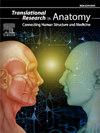Early white matter microstructural alterations in cerebral small vessel disease: A tract-specific diffusion tensor imaging and cardio-cerebrovascular risk perspective
Q3 Medicine
引用次数: 0
Abstract
Background
Silent cerebral small vessel disease (CSVD), marked by white matter hyperintensities (WMHs), are commonly detected incidentally on neuroimaging. Emerging evidence links early brain microstructural changes to modifiable cardio-cerebrovascular risks, even without neurological symptoms. This study aimed to explore the relationship between cardio-cerebrovascular risk, white matter tract integrity, and cognitive performance in asymptomatic adults, using QRISK3 profiling, diffusion tensor imaging (DTI), and neurocognitive evaluation.
Methods
Sixty neurologically asymptomatic adults (mean age: 39.8 ± 11.5 years) with low to moderate QRISK3 scores underwent standardized neurocognitive assessment 3T brain MRI, including DTI sequences. Lesion-guided region-of-interest (ROI) tractography was used to assess six bilateral white matter tracts commonly affected in CSVD: the anterior and superior corona radiata and the superior longitudinal fasciculus (SLF).
Results
WMHs were identified in 20 individuals (33.3 %). Their presence was significantly associated with aging, systolic blood pressure, hypertension, and QRISK3 score (p < 0.05). While no significant cognitive impairment was observed, processing speed was negatively correlated with age and QRISK3. Although DTI metrics such as fractional anisotropy (FA) and mean diffusivity (MD) did not significantly differ across groups, tract-specific analysis revealed that higher QRISK3 scores were significantly associated with reduced white matter integrity in the left SLF.
Conclusion
These findings highlight the presence of early, subclinical white matter alterations in individuals at cardio-cerebrovascular risk, even in the absence of neurological symptoms. The integration of tract-specific DTI analysis with vascular risk profiling may provide a sensitive approach for detecting preclinical CSVD and guiding early intervention strategies in at-risk populations.
脑小血管疾病早期白质微结构改变:导管特异性弥散张量成像和心脑血管风险视角
背景:以白质高信号(WMHs)为标志的无症状性脑血管疾病(CSVD)通常在神经影像学上偶然发现。新出现的证据将早期大脑微观结构的改变与可改变的心脑血管风险联系起来,即使没有神经系统症状。本研究旨在探讨无症状成人心脑血管风险、白质束完整性和认知表现之间的关系,采用QRISK3谱分析、弥散张量成像(DTI)和神经认知评估。方法对60名QRISK3评分中低的无神经症状成人(平均年龄:39.8±11.5岁)进行了标准化的神经认知评估3T脑MRI,包括DTI序列。病变引导感兴趣区(ROI)束道造影用于评估CSVD常见的6个双侧白质束:前、上辐射冠和上纵束(SLF)。结果20例(33.3%)患者中检出swmh。它们的存在与年龄、收缩压、高血压和QRISK3评分显著相关(p <;0.05)。处理速度与年龄和QRISK3负相关,但未观察到明显的认知障碍。尽管DTI指标(如分数各向异性(FA)和平均扩散率(MD))在各组之间没有显著差异,但通道特异性分析显示,较高的QRISK3评分与左侧SLF白质完整性降低显著相关。结论:这些发现表明,即使在没有神经系统症状的情况下,具有心脑血管风险的个体也存在早期的亚临床白质改变。将血管特异性DTI分析与血管风险分析相结合,可能为检测临床前CSVD提供一种敏感的方法,并指导高危人群的早期干预策略。
本文章由计算机程序翻译,如有差异,请以英文原文为准。
求助全文
约1分钟内获得全文
求助全文
来源期刊

Translational Research in Anatomy
Medicine-Anatomy
CiteScore
2.90
自引率
0.00%
发文量
71
审稿时长
25 days
期刊介绍:
Translational Research in Anatomy is an international peer-reviewed and open access journal that publishes high-quality original papers. Focusing on translational research, the journal aims to disseminate the knowledge that is gained in the basic science of anatomy and to apply it to the diagnosis and treatment of human pathology in order to improve individual patient well-being. Topics published in Translational Research in Anatomy include anatomy in all of its aspects, especially those that have application to other scientific disciplines including the health sciences: • gross anatomy • neuroanatomy • histology • immunohistochemistry • comparative anatomy • embryology • molecular biology • microscopic anatomy • forensics • imaging/radiology • medical education Priority will be given to studies that clearly articulate their relevance to the broader aspects of anatomy and how they can impact patient care.Strengthening the ties between morphological research and medicine will foster collaboration between anatomists and physicians. Therefore, Translational Research in Anatomy will serve as a platform for communication and understanding between the disciplines of anatomy and medicine and will aid in the dissemination of anatomical research. The journal accepts the following article types: 1. Review articles 2. Original research papers 3. New state-of-the-art methods of research in the field of anatomy including imaging, dissection methods, medical devices and quantitation 4. Education papers (teaching technologies/methods in medical education in anatomy) 5. Commentaries 6. Letters to the Editor 7. Selected conference papers 8. Case Reports
 求助内容:
求助内容: 应助结果提醒方式:
应助结果提醒方式:


